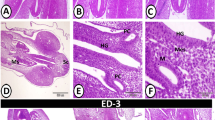Abstract
DURING an investigation of mucous secretion on the proboscis of Harrimania kupfferi1 ultra-thin sections were made of the epithelium of various parts of the body including proboscis, collar and the anterior parts of the trunk. In the epithelium of the ventral part of the trunk, immediately behind the collar, a distinct choanocyte type of cell was encountered.
This is a preview of subscription content, access via your institution
Access options
Subscribe to this journal
Receive 51 print issues and online access
$199.00 per year
only $3.90 per issue
Buy this article
- Purchase on Springer Link
- Instant access to full article PDF
Prices may be subject to local taxes which are calculated during checkout
Similar content being viewed by others
References
Nørrevang, A., Ann. N.Y. Acad. Sci. (in the press).
Fjerdingstad, E. J., Z. Zellforsch., 53, 645 (1961).
Rasmont, R., Ann. Sci. Nat. Zool., 12e Ser., 1, 253 (1959).
Fjerdingstad, E. J., Z. Zellforsch., 53, 499 (1961).
Author information
Authors and Affiliations
Rights and permissions
About this article
Cite this article
NØRREVANG, A. Choanocytes in the Skin of Harrimania kupfferi (Enteropneusta). Nature 204, 398–399 (1964). https://doi.org/10.1038/204398a0
Published:
Issue Date:
DOI: https://doi.org/10.1038/204398a0
This article is cited by
-
The ontogeny of choanocyte chambers during metamorphosis in the demosponge Amphimedon queenslandica
EvoDevo (2016)
-
Development of cilia in embryos of the turbellarian Macrostomum
Hydrobiologia (1981)
-
Monociliary receptors in interstitial Proseriata and Neorhabdocoela (Turbellaria Neoophora)
Zoomorphologie (1977)
-
Ciliary feeding of tornaria larvae of Ptychodera flava (Hemichordata: Enteropneusta)
Marine Biology (1976)
-
Evolutionary Implications of Collar Cell Ectoderm in a Coral Planula
Nature (1973)
Comments
By submitting a comment you agree to abide by our Terms and Community Guidelines. If you find something abusive or that does not comply with our terms or guidelines please flag it as inappropriate.



